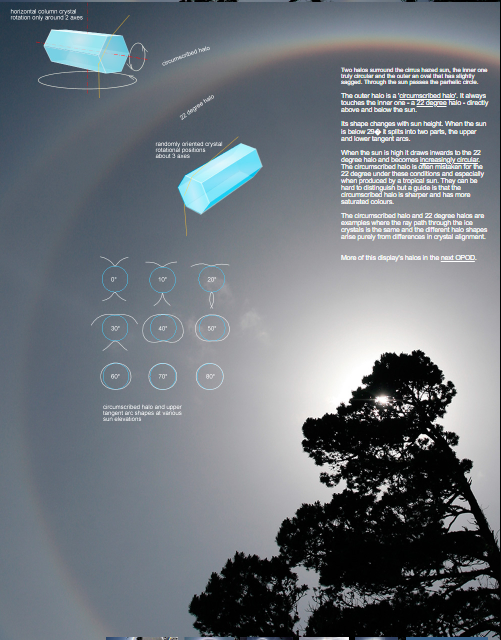Perfect Circumscribed Halo
Perfect Circumscribed Halo: A Fascinating Optical Phenomenon
Atmospheric optics never fails to amaze us with its captivating displays. One such phenomenon is the perfect circumscribed halo, which creates a stunning sight in the sky. This optical marvel is often accompanied by other rare ice halos, making it a spectacle worth observing and appreciating.
The perfect circumscribed halo is formed when two halos surround the sun, one inside the other. The inner halo, known as the 22-degree halo, appears as a truly circular ring. The outer halo, on the other hand, takes the form of an oval shape that sags slightly. Interestingly, the outer halo always touches the inner halo directly above and below the sun, giving it its distinctive appearance.
The shape of the circumscribed halo undergoes changes based on the height of the sun. When the sun is positioned below 29 degrees, the circumscribed halo splits into two parts known as the upper and lower tangent arcs. As the sun rises higher in the sky, the circumscribed halo draws closer to the 22-degree halo and gradually becomes more circular in shape.
One might mistake the circumscribed halo for the 22-degree halo, particularly when produced by a tropical sun. However, there are some distinguishing features to help differentiate between the two. The circumscribed halo tends to be sharper and exhibits more saturated colors compared to the 22-degree halo. These subtle differences in appearance allow keen observers to identify and appreciate the unique qualities of each halo.
It is fascinating to note that both the circumscribed halo and the 22-degree halo are formed due to the same ray path through ice crystals. The distinct shapes of these halos arise solely from variations in crystal alignment. This intricate interplay between light and ice crystals creates a mesmerizing display in the sky, captivating those fortunate enough to witness it.
While the perfect circumscribed halo is undoubtedly a sight to behold, it is often just one part of a larger display of halos and atmospheric phenomena. In the case of the image captured at Shore Acres, Oregon, there were several other ice halos present, some of which are considered rare. These additional halos add depth and complexity to the overall atmospheric spectacle, enhancing the visual experience for observers.
The perfect circumscribed halo serves as a reminder of the beauty and complexity of our atmosphere. It highlights the intricate mechanisms that govern the behavior of light and ice crystals, resulting in breathtaking optical phenomena. As we continue to explore and study atmospheric optics, we uncover more about the various halos and their formation processes, deepening our understanding of these natural wonders.
In conclusion, the perfect circumscribed halo is a remarkable optical phenomenon that captivates our senses and sparks curiosity about the workings of our atmosphere. Its unique shape and interaction with the 22-degree halo make it a visually intriguing sight. As we delve further into the realm of atmospheric optics, we uncover more about the intricacies of these halos and their formation, allowing us to appreciate the wonders of our natural world. So, keep your eyes to the sky and be ready to witness the awe-inspiring displays that nature has in store for us.

Perfect Circumscribed Halo - Imaged at Shore Acres, Oregon, USA by Phillip Bonn. This outstanding display had other ice halos - some rare. More about those in the next OPOD. ©Phillip Bonn, shown with permission.
Two halos surround the cirrus hazed sun, the inner one truly circular and the outer an oval that has slightly sagged. Through the sun passes the parhelic circle.
The outer halo is a 'circumscribed halo'. It always touches the inner one - a 22 degree halo - directly above and below the sun.
Its shape changes with sun height. When the sun is below 29� it splits into two parts, the upper and lower tangent arcs.
When the sun is high it draws inwards to the 22 degree halo and becomes increasingly circular. The circumscribed halo is often mistaken for the 22 degree under these conditions and especially when produced by a tropical sun. They can be hard to distinguish but a guide is that the circumscribed halo is sharper and has more saturated colours.
The circumscribed halo and 22 degree halos are examples where the ray path through the ice crystals is the same and the different halo shapes arise purely from differences in crystal alignment.
More of this display's halos in the next OPOD.

Note: this article has been automatically converted from the old site and may not appear as intended. You can find the original article here.
Reference Atmospheric Optics
If you use any of the definitions, information, or data presented on Atmospheric Optics, please copy the link or reference below to properly credit us as the reference source. Thank you!
-
<a href="https://atoptics.co.uk/blog/perfect-circumscribed-halo/">Perfect Circumscribed Halo</a>
-
"Perfect Circumscribed Halo". Atmospheric Optics. Accessed on November 22, 2024. https://atoptics.co.uk/blog/perfect-circumscribed-halo/.
-
"Perfect Circumscribed Halo". Atmospheric Optics, https://atoptics.co.uk/blog/perfect-circumscribed-halo/. Accessed 22 November, 2024
-
Perfect Circumscribed Halo. Atmospheric Optics. Retrieved from https://atoptics.co.uk/blog/perfect-circumscribed-halo/.